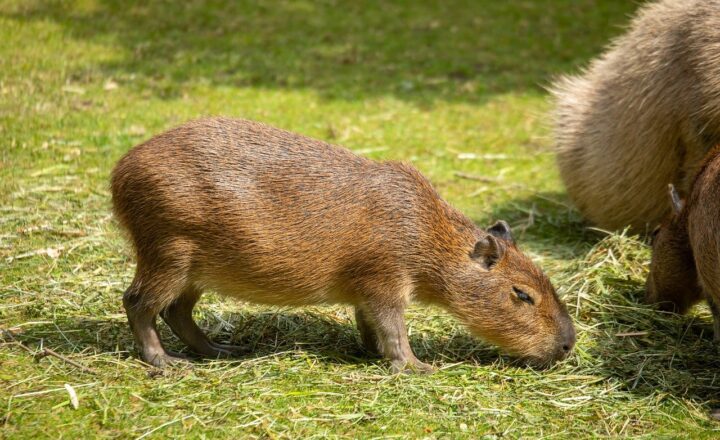Capybara Care 101: Everything You Need to Know About Owning a Capybara as a Pet
November 13, 2024

Capybaras, the world’s largest rodents, are increasingly becoming popular pets due to their sociable nature and gentle demeanor. Hailing from South America, these fascinating creatures require specific care guidelines to thrive in a domestic environment. In this comprehensive guide, we’ll explore everything you need to know about capybara care, from their dietary needs to social behaviors and environmental requirements.
1. Understanding Capybaras: A Quick Overview
Capybaras (Hydrochoerus hydrochaeris) are semi-aquatic mammals native to the wetlands of South America. They are known for their friendly demeanor and are often social animals, preferring the company of other capybaras or pets. As a pet owner, understanding their social needs is critical to their happiness.
Key Characteristics of Capybaras:
- Size: Adult capybaras can weigh between 77 to 150 pounds and measure about 4 feet long.
- Lifespan: Under proper care, capybaras live between 8 to 12 years.
- Diet: They are herbivores, primarily grazing on grasses and aquatic plants.
Being informed about their traits and needs is essential for any potential capybara owners.
2. Setting Up the Ideal Living Environment
Capybaras need a safe and comfortable habitat that mimics their natural environment. Here’s what you need to consider:
2.1 Space Requirements
Capybaras need a spacious area to roam, preferably a pen or fenced yard that is at least 100 square feet for a couple. Providing access to more space allows them to exhibit their natural behaviors.
2.2 Water Features
As semi-aquatic animals, capybaras love water. Having a small pool or pond where they can immerse themselves is essential. Ensure the water is clean and regularly maintained to keep your capybara healthy.
2.3 Shelter
Create a cozy shelter where your capybara can stay dry and safe from harsh weather conditions. A wooden shelter or a large dog house works well, keep it ventilated yet insulated from extreme temperatures.
3. Dietary Needs of Capybaras
Feeding your capybara a balanced diet is vital to its health. Here’s a breakdown of their dietary requirements:
3.1 Hay and Grasses
The foundation of a capybara’s diet should consist of high-quality hay and fresh grasses. Timothy hay and orchard grass are excellent choices, providing the necessary fiber.
3.2 Fresh Vegetables
Introduce a variety of fresh vegetables such as carrots, sweet potatoes, and leafy greens (e.g., kale or romaine) in moderation to ensure a balanced diet.
3.3 Commercial Pellets
You may also provide species-specific pellets that are formulated for rodents, making sure they are free from artificial additives.
3.4 Hydration
Always ensure that a clean water source is available for hydration; capybaras drink a lot of water daily.
4. Social Needs and Behavior
Capybaras are highly social and do not thrive alone. Understanding their social needs is crucial:
4.1 Companionship
It’s recommended to keep them in pairs or groups, as they thrive on social interactions with fellow capybaras.
4.2 Interaction with Humans
While they need capybara companionship, they can also bond with humans. Spend time playing and interacting with them daily; this strengthens your bond and reduces stress.
4.3 Training and Enrichment
Capybaras can be trained to a certain extent. Use positive reinforcement methods to teach them commands or tricks, and provide enrichment activities to stimulate their minds and prevent boredom.
5. Health Care for Capybaras
Owning a capybara means ensuring regular veterinary care:
5.1 Routine Check-ups
Schedule veterinary visits at least once a year for routine check-ups, vaccinations, and to monitor their overall health.
5.2 Parasite Control
Consult your vet about appropriate parasite control measures to protect your capybara from ticks, fleas, and other pests.
5.3 Signs of Illness
Be vigilant of any behavioral changes, loss of appetite, or unusual lethargy as these can indicate health issues. Address these signs promptly with a veterinarian.
6. Legal Considerations and Challenges
Before welcoming a capybara into your home, consider the regulations that may apply. In some states, owning a capybara may require a permit or may even be illegal. Research your local laws to ensure compliance.
Additionally, thoughtful consideration of the challenges involved in capybara ownership is essential:
6.1 Commitment
Capybaras require time and attention to ensure they lead happy and healthy lives. Be prepared to invest time daily in their care and socialization.
6.2 Cost of Care
The initial setup, ongoing veterinary care, and daily food can add up. Ensure you have the financial resources to provide for your capybara’s needs.
Conclusion
Owning a capybara can be a rewarding experience for pet lovers willing to cater to their needs. With proper care, a balanced diet, and the right living environment, you can create a nurturing space for your capybara to thrive. These gentle giants, with their playful personalities and social nature, can become wonderful companions when provided with the right setting to flourish. If you’re ready to embark on this adventurous journey, ensure you are well-educated and prepared to welcome a capybara into your family.
If you’re contemplating this unique pet ownership experience, do your research, connect with other capybara owners, and prepare adequately to bond with these fascinating creatures.






